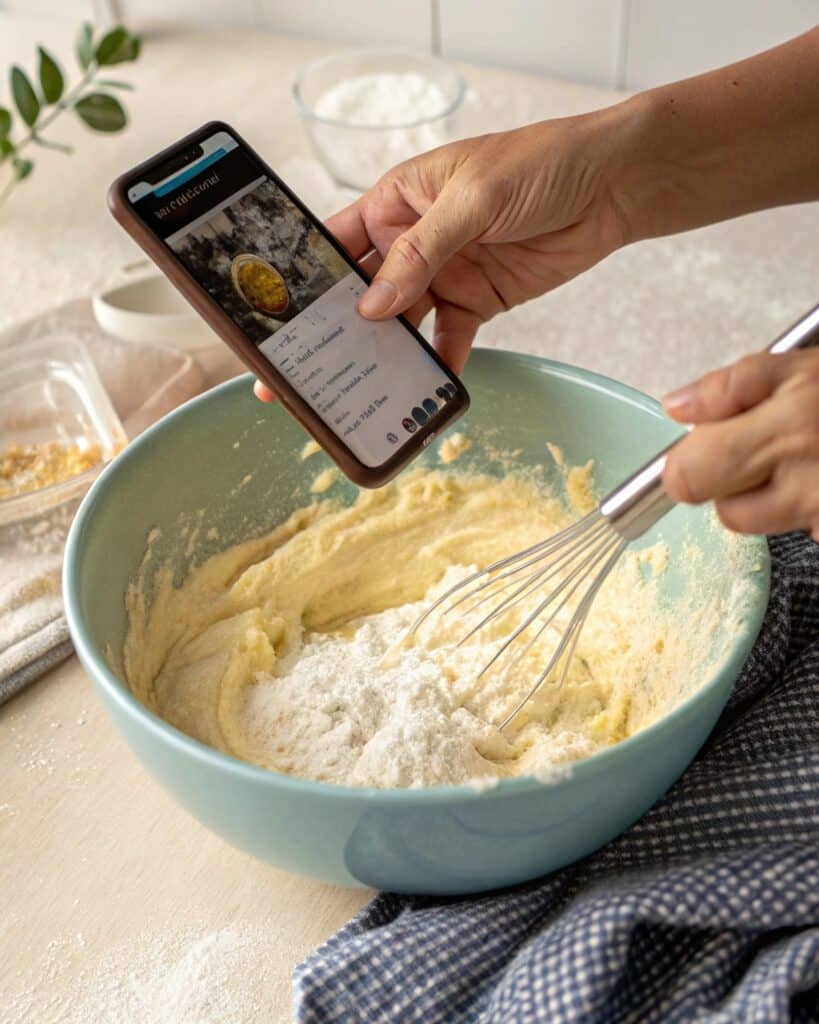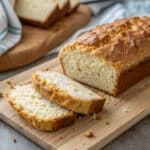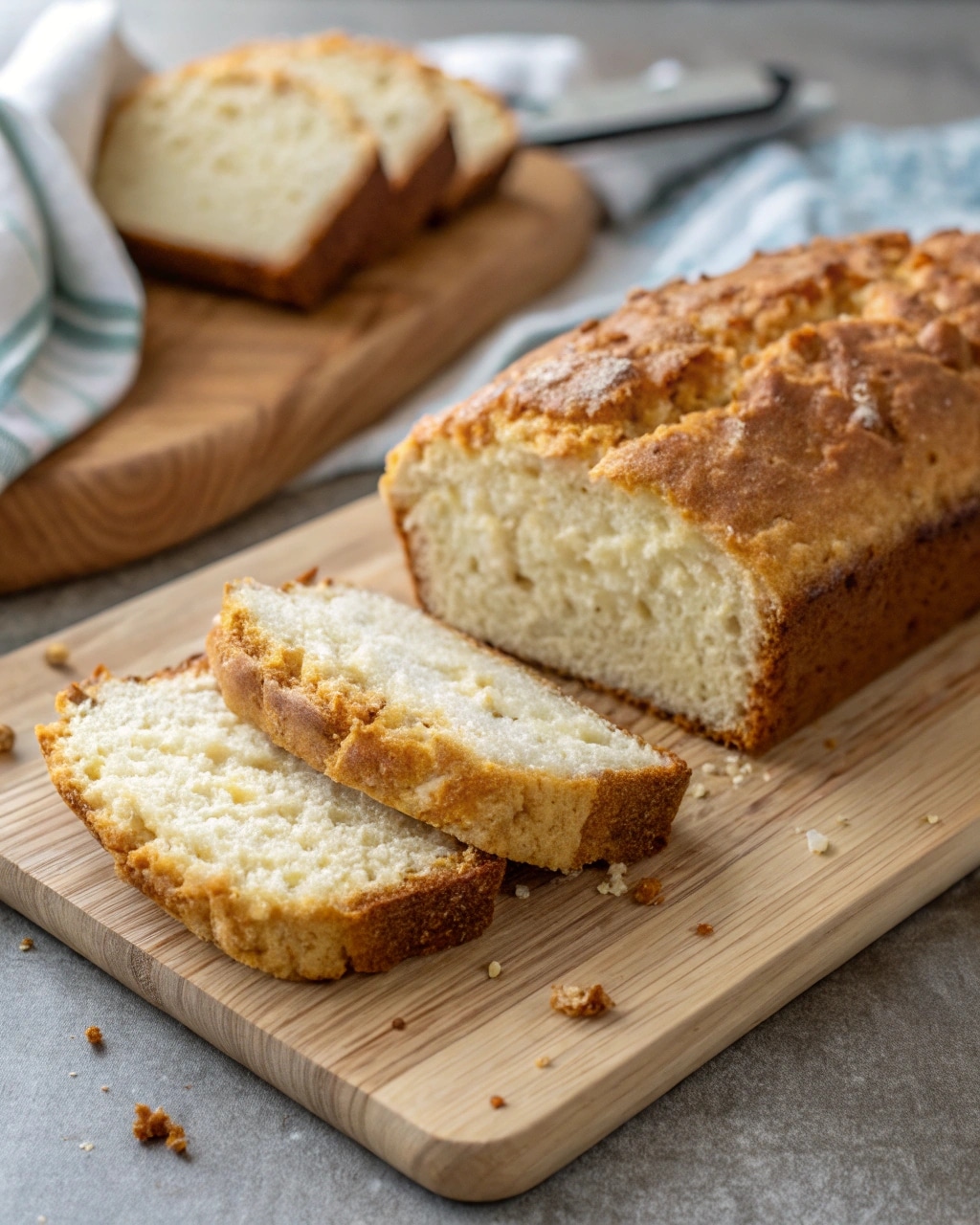If you’re tired of heavy, carb-loaded bread and want a delicious, healthier alternative, flourless cottage cheese bread is about to be your new favorite. This unique recipe ditches the flour completely and uses protein-packed cottage cheese as the star ingredient, creating a moist, tender loafCottage cheese is the main ingredient, adding moisture, protein, and a mildly tangy taste. that’s perfect for anyone watching their carbs or trying to boost protein intake.
Unlike typical breads that leave you feeling sluggish, this no-flour version offers a light yet satisfying texture that works great for breakfast, sandwiches, or as a snack. Not only is it gluten-free and low-carb, but it also adds a creamy tang that sets it apart from other bread alternatives.
Key Ingredients and Substitutions
Essential ingredients for the perfect loaf
To make a perfect loaf of flourless cottage cheese bread, you don’t need a long grocery list. The beauty of this recipe lies in its simplicity. The core ingredients include:
- Cottage cheese is the main ingredient, adding moisture, protein, and a mildly tangy taste.. Look for full-fat or low-fat options, depending on your dietary preferences.
- Eggs: Acting as a binder, eggs help hold the bread together and add structure. They also add additional protein and healthy fats.
- Baking powder: Essential for giving the bread lift and keeping it airy rather than dense.
- Salt improves the taste and helps balance the richness of the cottage cheese.
You might also consider optional add-ins to elevate the flavor and nutrition. Fresh herbs like rosemary or thyme, garlic powder, or even a sprinkle of grated cheese on top can give it a gourmet twist.
Cottage cheese has a mild flavor, so it easily takes on added spices and seasonings. For a savory touch, you can mix in sun-dried tomatoes, olives, or chopped spinach.
Smart substitutions for different dietary needs
The great thing about flourless cottage cheese bread is its versatility. You can easily adapt it to fit various dietary needs or ingredient availability.
- Dairy-free option: If you’re avoiding dairy, try using a dairy-free cottage cheese alternative or blended silken tofu. While the texture might be slightly different, it still results in a moist, protein-rich bread.
- Egg substitutes: If you’re vegan or allergic to eggs, you can experiment with flax eggs (one tablespoon ground flaxseed mixed with three tablespoons of water per egg) or commercial egg replacers. These additions can slightly lower the rise and make the texture denser.
- Extra protein boost: Add a scoop of unflavored protein powder or a bit of Greek yogurt for extra protein and creaminess.
Step-by-Step Guide to Making Flourless Cottage Cheese Bread

Preparing your ingredients and tools
Before you start baking your flourless cottage cheese bread, it’s important to prep everything ahead of time. Pre-measuring and organizing your ingredients will make the process smoother and help ensure success on the first try.
Essential tools you’ll need:
- Mixing bowls (one large, one medium)
- Hand mixer or whisk
- Silicone or parchment-lined loaf pan
- Rubber spatula
- Measuring cups and spoons
Ingredient checklist:
- 1 1/2 cups cottage cheese (full-fat for extra richness)
- 4 large eggs
- 1 tablespoon baking powder
- 1/2 teaspoon salt
- Optional add-ins (herbs, seeds, spices)
Start by preheating your oven to 350°F (175°C). Grease the loaf pan or use parchment paper to stop the bread from sticking.
If your cottage cheese is chunky, consider blending it briefly to create a smoother texture. This small step can make a big difference in the final consistency of your bread.
Baking steps and troubleshooting tips
- Mix wet ingredients
In your large mixing bowl, add the cottage cheese and eggs. Use a hand mixer or whisk to blend until the mixture is smooth and well combined. combined. This step ensures the cottage cheese fully integrates with the eggs, helping avoid lumps in the final loaf. - Add dry ingredients
Gradually fold in the baking powder and salt using a rubber spatula. Avoid overmixing here; gently folding keeps the bread light and airy. - Incorporate optional add-ins
Now’s the time to add any herbs, seeds, or extra flavorings. Gently stir them into the batter to distribute evenly without deflating the mixture. - Transfer to loaf pan
Pour the batter into your prepared pan, using a spatula to smooth the top. You can add sesame seeds or grated cheese on top for extra flavor. - Bake to perfection
Put the pan in the preheated oven and bake for 45 to 55 minutes. Check for doneness by inserting a toothpick into the center; if it comes out clean, your bread is ready. - Cool before slicing
Let the bread sit in the pan for 10 minutes before placing it on a wire rack. Let it cool completely before slicing to avoid crumbling.
Troubleshooting tips:
- If your bread is too dense, it may be due to overmixing or not enough leavening (baking powder).
- If the bread falls apart when slicing, ensure it has fully cooled and consider blending your cottage cheese more smoothly next time.
- If the loaf doesn’t rise enough, check that your baking powder is fresh and properly measured.
Comparing Flourless Cottage Cheese Bread with Other Low-Carb Breads
How it stacks up against almond flour and coconut flour breads
When it comes to low-carb breads, almond flour and coconut flour versions have become household staples. However, flourless cottage cheese bread offers unique advantages that might surprise you.
Texture and moisture
Almond flour breads tend to be dense and heavy because of the fat content in nuts. While they’re filling, they can sometimes feel too rich or grainy. Coconut flour breads, on the other hand, are often dry and require a lot of eggs and liquid to maintain moisture, leading to an eggy taste some people find off-putting.
Flourless cottage cheese bread finds a happy middle ground. Thanks to the moisture and creaminess of cottage cheese, this bread stays light, fluffy, and moist without requiring a heavy mix of extra ingredients. You get a smooth, soft crumb that feels closer to traditional bread.
Nutritional profile
Almond flour has vitamin E and healthy fats, while coconut flour is high in fiber. But both options are calorie-dense. Flourless cottage cheese bread is typically lower in calories and fat, while being higher in protein per slice. This makes it a fantastic choice if you’re focusing on protein intake without excessive calories or fats.
Flavor versatility
Cottage cheese bread has a mild, creamy taste that pairs beautifully with both sweet and savory dishes. Almond flour has a distinct nutty flavor, and coconut flour has a strong coconut taste, which can limit your topping and pairing options.
Why choose cottage cheese over other alternatives
Protein powerhouse
Cottage cheese is an excellent source of casein protein, which digests slowly and keeps you feeling satisfied longer. This makes flourless cottage cheese bread a smart choice for athletes, busy professionals, or anyone trying to maintain stable energy levels throughout the day.
Lower carb count
While both almond and coconut flour breads are lower in carbs than wheat bread, flourless cottage cheese bread is even lower due to the absence of flour altogether. This makes it an appealing option for strict low-carb or keto lifestyles.
Fewer ingredients and simpler prep
Most almond and coconut flour breads require multiple binders and stabilizers, like psyllium husk or xanthan gum, to achieve a good structure. Flourless cottage cheese bread, on the other hand, comes together with just a handful of simple, whole ingredients. It’s less fussy and easier for beginner bakers.
Frequently Asked Questions about Flourless Cottage Cheese Bread
What is bread without flour called?
Bread made without flour is generally referred to as flourless bread. These types of breads often rely on eggs, dairy, nut butters, or seeds to create structure and texture instead of traditional grain-based flours. Flourless cottage cheese bread falls into this category, offering a unique, protein-rich option that’s completely gluten-free and low in carbs.
Flourless breads are gaining popularity among those looking to avoid gluten, reduce carbohydrates, or simply experiment with new flavors and textures in their diets.
Can cottage cheese replace flour?
While cottage cheese cannot directly replace flour in traditional baking, it can act as a major ingredient in flourless recipes like flourless cottage cheese bread. Here, it helps create moisture, structure, and a light, airy crumb without the need for any grain-based flours.
Instead of providing the bulk and starch that flour usually offers, cottage cheese works together with eggs to bind the ingredients and add creaminess. It’s not a one-to-one flour substitute but an innovative way to reimagine bread completely.
Is cottage cheese bread healthy for you?
Absolutely. Flourless cottage cheese bread is considered a healthier alternative to traditional breads for several reasons.
First, it’s high in protein, supporting muscle repair and helping you feel full longer. It’s also lower in carbs, making it suitable for low-carb, keto, and diabetic-friendly diets. Additionally, it’s gluten-free, ideal for those with gluten sensitivity or celiac disease.
Moreover, cottage cheese provides valuable nutrients like calcium, phosphorus, selenium, and B vitamins. With no refined flour or added sugars, this bread aligns well with many health-focused eating plans.
Why does my cottage cheese flatbread fall apart?
This is a common issue and usually comes down to a few key factors:
- Not enough eggs: Eggs help bind the bread. Skimping on them or using incorrect substitutes can lead to crumbling.
- Improper mixing: Unevenly mixed cottage cheese or dry spots in the batter can cause weak points that break apart when sliced.
- Slicing too soon: Allowing the bread to cool completely is crucial. Cutting it while still warm lets moisture escape too quickly, making it fragile.
- Overloading add-ins: Too many vegetables, seeds, or toppings can make the bread heavy and prone to falling apart.
Internal Links Recap (Extracted Internal Links)
- High-protein breakfast recipes
- Easy gluten-free meal prep
- Creative low-carb dinner ideas
- Easy healthy sandwich recipes
- Best low-carb baking ingredients
- Expert baking tips for beginners
- Troubleshooting guide for gluten-free baking
- Ultimate guide to high-protein snacks

Flourless Cottage Cheese Bread
- Total Time: 1 hour
- Yield: 1 loaf (about 10 slices) 1x
Description
This Flourless Cottage Cheese Bread is a high-protein, low-carb alternative to traditional bread. It’s light, moist, and perfect for anyone looking for a gluten-free, healthier option that pairs well with both savory and sweet toppings.
Ingredients
- 1 1/2 cups cottage cheese (full-fat preferred for richer texture)
- 4 large eggs
- 1 tablespoon baking powder
- 1/2 teaspoon salt
- Optional: Fresh herbs (rosemary, thyme), seeds, or grated cheese for topping
Instructions
- Prepare your oven and pan: Preheat oven to 350°F (175°C). Grease or line a loaf pan with parchment paper.
- Blend the wet ingredients: In a large mixing bowl, blend cottage cheese and eggs until smooth using a hand mixer or whisk.
- Add dry ingredients: Gently fold in baking powder and salt until just combined. Avoid overmixing.
- Customize: Add any herbs, seeds, or flavorings as desired and fold gently.
- Pour and smooth: Transfer batter into the prepared pan and smooth the top with a spatula. Add optional toppings if desired.
- Bake: Bake for 45–55 minutes until golden and a toothpick inserted comes out clean.
- Cool completely: Let the bread cool in the pan for 10 minutes, then transfer to a wire rack and cool fully before slicing to prevent crumbling.
Notes
For best results, blend the cottage cheese until smooth before mixing. Allow the bread to cool completely to maintain structure when slicing. Store in the fridge for up to 5 days or freeze slices for longer storage.
- Prep Time: 10 minutes
- Cook Time: 50 minutes
- Category: Bread
- Method: Baking
- Cuisine: Healthy/Gluten-Free
Nutrition
- Serving Size: 1 slice
- Calories: 110
- Sugar: 1g
- Sodium: 300mg
- Fat: 5g
- Saturated Fat: 2g
- Unsaturated Fat: 2g
- Trans Fat: 0g
- Carbohydrates: 3g
- Fiber: 0g
- Protein: 10g
- Cholesterol: 90mg

